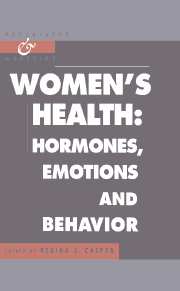Book contents
- Frontmatter
- Contents
- Preface
- 1 Growing up female
- 2 Reproduction and its psychopathology
- 3 Women's sexual function and dysfunction
- 4 Gender differences in brain morphology and in psychiatric disorders
- 5 Thyroid hormones in major depressive disorder and bipolar disorder
- 6 The hypothalamic-pituitary-adrenocortical system
- 7 The cost of starvation: Eating disorders
- 8 Coronary artery disease and women: Estrogens and psychosocial and lifestyle risk factors
- 9 The psychophysiology of breast cancer: Disease, hormones, immunity, and stress
- 10 The psychopharmacology of women
- 11 Intervention trials concerned with disease prevention in women
- References
- Index
3 - Women's sexual function and dysfunction
Published online by Cambridge University Press: 08 February 2010
- Frontmatter
- Contents
- Preface
- 1 Growing up female
- 2 Reproduction and its psychopathology
- 3 Women's sexual function and dysfunction
- 4 Gender differences in brain morphology and in psychiatric disorders
- 5 Thyroid hormones in major depressive disorder and bipolar disorder
- 6 The hypothalamic-pituitary-adrenocortical system
- 7 The cost of starvation: Eating disorders
- 8 Coronary artery disease and women: Estrogens and psychosocial and lifestyle risk factors
- 9 The psychophysiology of breast cancer: Disease, hormones, immunity, and stress
- 10 The psychopharmacology of women
- 11 Intervention trials concerned with disease prevention in women
- References
- Index
Summary
Introduction
Before the scientific era produced equipment capable of microscopic scrutiny of semen and ova, human sexuality was shrouded in myth. Female sexuality was hidden in mystique even from women, who were educated by husbands who usually knew less than they did. Infertility was blamed on the wife, and several queens of England lost their lives because there was no male baby.
History
Although sexual enjoyment is not necessarily associated with parity, the early researchers into sexual problems were male gynecologists in the field of infertility. Robert Dickinson, M.D., of Cleveland Clinic, a remarkable gynecologist pioneer, was the first to do couples' counseling when he noted how great a role sexual ignorance played in infertility. He molded wax into models of the genitals with a sagittal section of the female pelvis to educate both husband and wife in internal, as well as external, anatomy and in coital techniques. Dr. Dickinson inspired and advised Alfred Kinsey, Ph.D., whose marathon sociologic sex research team interviewed 8,000 men in the 1940s, and then 12,000 women in the 1950s. By 1950, Joseph Wolpe, a psychiatrist from Philadelphia, had evolved “reciprocal inhibition,” a systematic relaxation technique to desensitize women who were anorgasmic, which was then called frigidity (now considered an outmoded and pejorative term because emotional warmth was present).
Building upon the scientific shoulders of the researchers before him, William Masters, M.D., a gynecologist from St. Louis, was also impressed by the many sexual problems of infertile couples (Masters and Johnson, 1966). He first studied his own sexual theories about the cause of sexual symptoms by careful laboratory observations; then, over 5 years, he documented on film the sexual performance of 135 couples (men and women from 19 to 50 years) in solo and coital sexual activity (Masters and Johnson, 1966).
- Type
- Chapter
- Information
- Women's HealthHormones, Emotions and Behavior, pp. 36 - 52Publisher: Cambridge University PressPrint publication year: 1997



